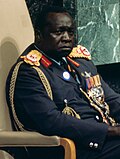Top Qs
Timeline
Chat
Perspective
List of heads of state of Uganda
From Wikipedia, the free encyclopedia
Remove ads
This is a list of the heads of state of Uganda, from the independence of Uganda in 1962 to the present day.
From 1962 to 1963, the head of state under the Constitution of 1962 was the queen of Uganda, Elizabeth II, who was also the monarch of other Commonwealth realms. The queen was represented in Uganda by a governor-general. Uganda removed Elizabeth II as head of state under a 1963 constitutional amendment and the monarch and governor-general were replaced by a ceremonial president. The president under the 1963 constitution was an elective monarch, chosen by the parliament from among Uganda's five traditional kings. Uganda became a republic within the Commonwealth when this system was replaced by an executive presidency in 1966.
Remove ads
Commonwealth realm (1962–1963)
Summarize
Perspective
The succession to the throne was the same as the succession to the British throne.
Governor-general
The governor-general was the representative of the monarch in Uganda and exercised most of the powers of the monarch. The governor-general was appointed for an indefinite term, serving at the pleasure of the monarch. Since Uganda was granted independence by the Uganda Independence Act 1962, rather than being first established as a semi-autonomous dominion and later promoted to independence as defined by the Statute of Westminster 1931, the governor-general was to be always appointed solely on the advice of the Cabinet of Uganda without the involvement of the British government. As Uganda became a republic before Walter Coutts, the former colonial governor, was replaced, this has never happened. In the event of a vacancy, the chief justice would have served as the officer administering the government under a dormant commission.
Remove ads
Elective monarchy (1963–1966)
Under the 1963 Constitution of the Sovereign State of Uganda, the British monarch was replaced as ceremonial head of state by an elective monarch with the title of president. The president was elected by the Parliament for a 5-year term from among the kings of Uganda’s five kingdoms and constitutional heads of districts, which were the monarchs of the non-federated entities.[a] In the event of a vacancy the Vice President served as acting president.
Remove ads
Republic (1966–present)
Summarize
Perspective
- Political parties
- Other factions
- Status
Denotes acting president
First Republic (1966–1971)
Under the 1966 "pigeon hole" constitution, the Sovereign State was abolished and replaced by the Republic of Uganda. The presidential office was transformed from a monarchical to an executive republican one. The president and vice-president were elected by the National Assembly.[2] The powers of the president were increased, with the establishment of the executive presidency, but the same rules applied concerning the vacancy of the president. It also applied to the 1967 and 1995 constitutions.
Second Republic (1971–1979)
General (later field marshal) Idi Amin led a coup d'état that overthrew President Obote and his government and installed himself as president.
Third Republic (1979–1985)
Military rule (1985–1986)
General Bazilio Olara-Okello led a coup d'état that overthrew President Obote and his government. Following the coup, Okello proclaimed himself president.
Fourth Republic (1986–present)
Under the Constitution of Uganda, the president is the executive head of state. The president is elected by popular vote for a five-year term. In the event of a vacancy, the vice president serves as acting president under a dormant commission.[3]
Remove ads
Timeline since 1963

Notes
References
External links
Wikiwand - on
Seamless Wikipedia browsing. On steroids.
Remove ads








